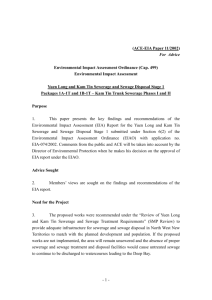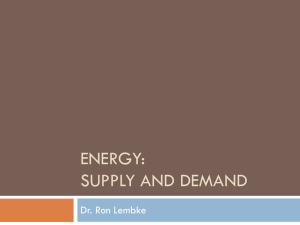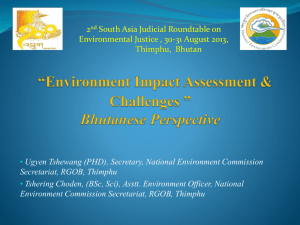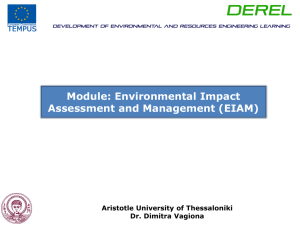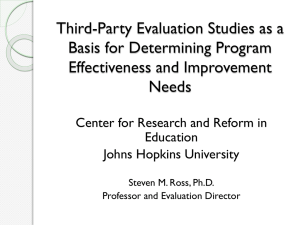Colin Cobbing Presentation
advertisement
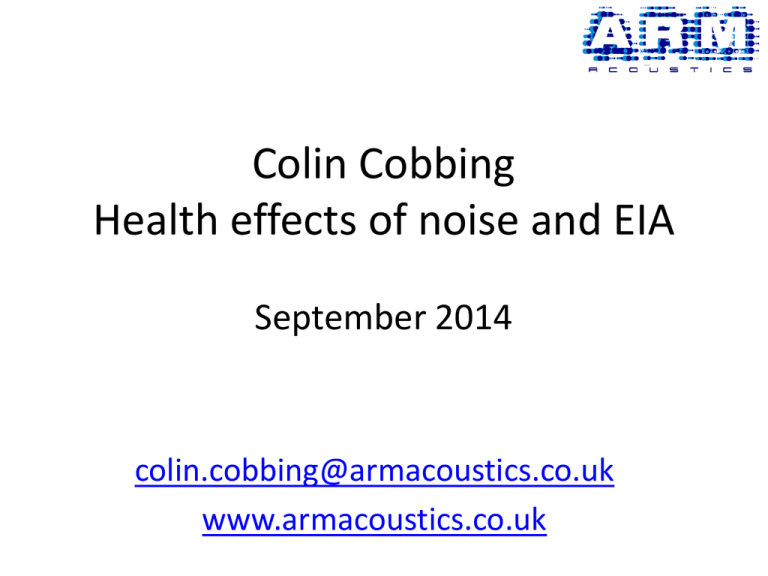
Colin Cobbing Health effects of noise and EIA September 2014 colin.cobbing@armacoustics.co.uk www.armacoustics.co.uk EIA Directives • EIA is required to determine likely significant effects of major projects such as a new railway. • EIA Regulations require the identification of likely significant effects (both positive and negative), and the description of the measures envisaged in order to avoid, reduce and, if possible, remedy significant adverse effects Health effects of noise and EIA • Some confusion as to whether EIA should include the health effects of noise • Any confusion which may have prevailed is now reconciled by the 2014 EIA Directive i.e. the effects on human health are now included in the information that must be assessed and reported. Health effects of noise • The health effects of noise will depend upon definition. • WHO definition of health is the most widely accepted i.e. complete state of physical, mental and social well-being. • The health effects of noise will include annoyance, sleep disturbance, cognitive impairment, interference with communication, cardiovascular effects and mental health effects. Babish model for health effects EIA and noise policy • The 2014 EIA Directive strengthens the link between EIA and National Noise Policy. Point 5 of Annex IV is reproduced • “The description of the likely significant effects on the factors specified in Article 3(1) should cover the direct effects and any indirect, secondary, cumulative, transboundary, short-term, medium-term and long-term, permanent and temporary, positive and negative effects of the project. This description should take into account the environmental protection objectives established at Union or Member State level which are relevant to the project.” Noise and health • There is increasing recognition and importance of noise and health and quality of life • Noise Policy Statement for England 2010 Scoping • Scoping should include identifying potential effects on human beings and aspects of human health that may be affected • Important to recognise that noise exposure is only a proxy for effects on humans Methodology • Methodology be developed to address the effects on quality of life and health • Different effects may need to be considered separately to reflect the differences in response e.g. sleep disturbance be considered separately from annoyance and that different methods/ descriptors be used for different effects, • Scientific evidence on the effects of noise be used to inform the methodology • The methodology must deal with uncertainty and limitations. HS2 impact criteria- residential Direct long term operational sound impacts identified where: • An absolute sound level at or above 50 dB LpAeq,16hr (day) and 40 dB LpAeq,8hr (night) and the magnitude of the impact and its effect on a receptor is indicated by the change in the equivalent continuous sound level as defined in Table 33. SMR Table 33 Airborne sound from operational train or road movements - impact criteria Long term Short term Impact Impact Classification Classification Sound level change dB LpAeq,T (positive or negative) T = either 16hr day or 8hr night Negligible Negligible ≥ 0 dB and < 1 dB Minor Minor Moderate ≥ 1 dB and < 3 dB ≥ 3 dB and < 5 dB Moderate Major ≥ 5 dB and < 10 dB Major ≥ 10 dB Significant effects- residential Significant effects determined taking account factors: • Type of effect being considered; • The number and grouping of receptors subject to impacts; • The magnitude of the impacts and available dose-response information; • The existing sound environment in terms of the absolute level and the character of the existing soundscape; • Any unique features which may require secondary acoustic indicators / criteria); • The potential combined impacts of sound and vibration HS2 effects criteria for residential- 2 • Operational noise significant adverse effect identified where absolute free-field sound level at or above 65 dB LpAeq,16hr (day) • At night an absolute free-field sound level at or above 55 dB LpAeq,8hr; or • 85 dB LpAFmax (outside) (where the number of events exceeding this value is less than or equal to 20); or • A level above 80 dB LpAFmax at the façade (outside) of a residential receptor (where the number of events exceeding this value is greater than 20).
